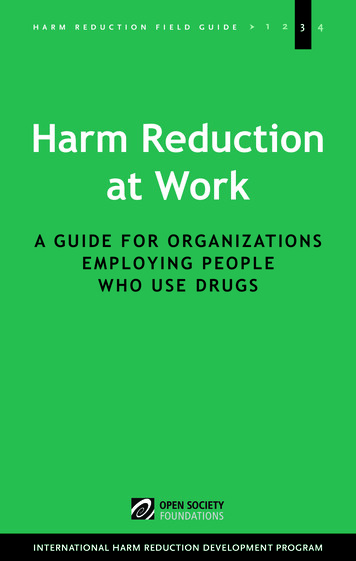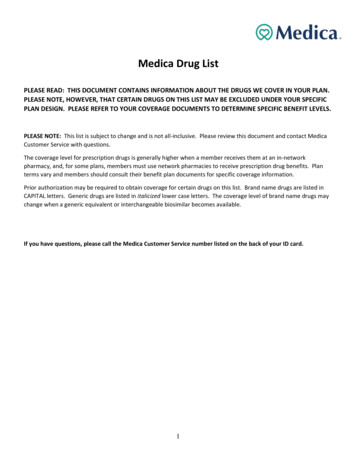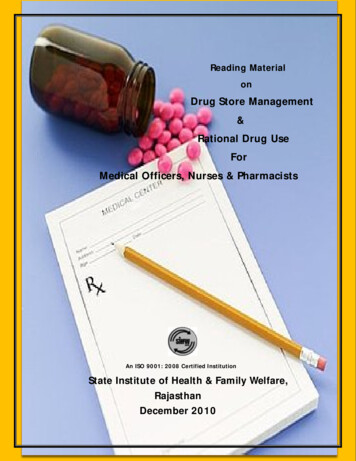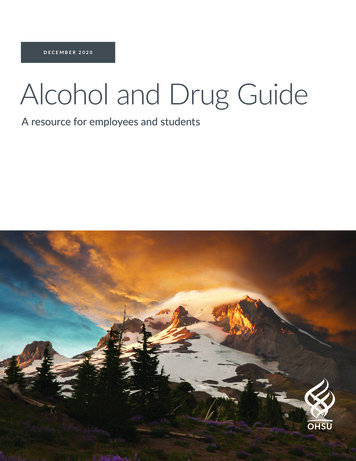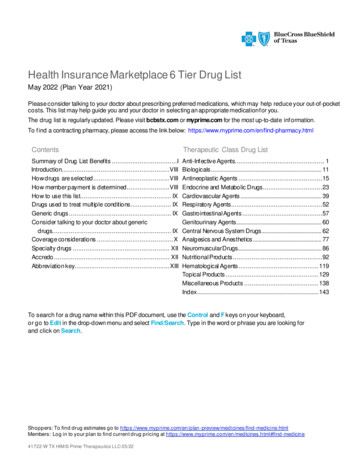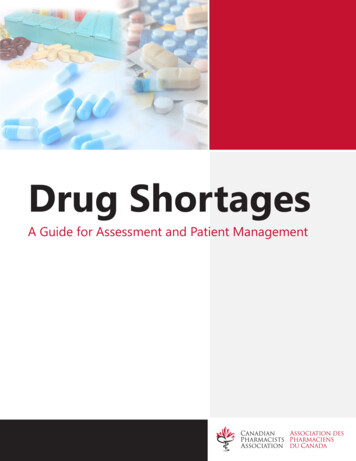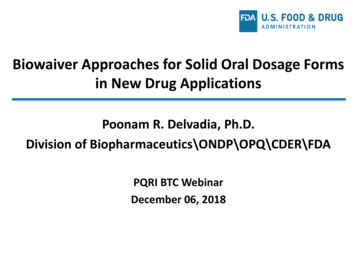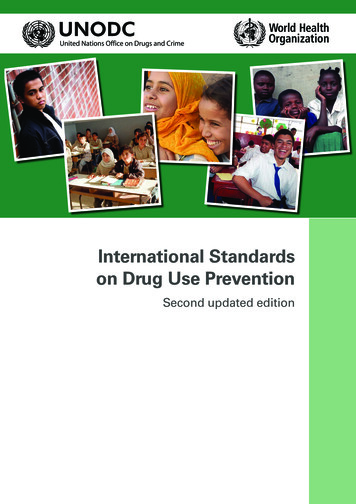
Transcription
International Standardson Drug Use PreventionSecond updated edition
Cover photo credits (left to right): iStockphoto.com/Quavondo; UN Photo/John Isaac; UN Photo/Evan Schneider; UNODC; UN Photo/Myriam Asmani.
UNITED NATIONS OFFICE ON DRUGS AND CRIMEViennaInternational StandardsonDrug Use PreventionSecond updated editionUNITED NATIONSVienna, 2018
International Standards on Drug Use Prevention, Second updated edition United Nations Office on Drugs and Crime (UNODC) and the World Health Organization, 2018ISBN 978-92-4-151448-4Some rights reserved. This work is available under the Creative Commons Attribution-NonCommercialShareAlike 3.0 IGO licence (CC BY-NC-SA 3.0 IGO; igo).Under the terms of this licence, you may copy, redistribute and adapt the work for non-commercialpurposes, provided the work is appropriately cited, as indicated below. In any use of this work, thereshould be no suggestion that UNODC or WHO endorses any specific organization, products or services.The unauthorized use of the UNODC or WHO names or logos is not permitted. If you adapt the work,then you must license your work under the same or equivalent Creative Commons licence. If you createa translation of this work, you should add the following disclaimer along with the suggested citation:“This translation was not created by the United Nations Office on Drugs and Crime (UNODC) or theWorld Health Organization (WHO). Neither UNODC nor WHO are responsible for the content oraccuracy of this translation. The original English edition shall be the binding and authentic edition.”Any mediation relating to disputes arising under the licence shall be conducted in accordance with themediation rules of the World Intellectual Property Organization (www.wipo.int/amc/en/mediation/rules).Suggested citation. International Standards on Drug Use Prevention, Second updated edition.Vienna: United Nations Office on Drugs and Crime and the World Health Organization, 2018. Licence:CC BY-NC-SA 3.0 IGO.Cataloguing-in-Publication (CIP) data. CIP data are available at http://apps.who.int/iris.Third-party materials. If you wish to reuse material from this work that is attributed to a third party,such as tables, figures or images, it is your responsibility to determine whether permission is needed forthat reuse and to obtain permission from the copyright holder. The risk of claims resulting from infringement of any third-party-owned component in the work rests solely with the user.General disclaimers. The designations employed and the presentation of the material in this publicationdo not imply the expression of any opinion whatsoever on the part of UNODC or WHO concerningthe legal status of any country, territory, city or area or of its authorities, or concerning the delimitationof its frontiers or boundaries. Dotted and dashed lines on maps represent approximate border lines forwhich there may not yet be full agreement.The mention of specific organizations, companies or of certainproducts or programmes does not imply that they are endorsed or recommended by UNODC or WHOin preference to others of a similar nature that are not mentioned. Errors and omissions excepted, thenames of proprietary products are distinguished by initial capital letters.All reasonable precautions have been taken by UNODC and WHO to verify the information containedin this publication. However, the published material is being distributed without warranty of any kind,either expressed or implied. The responsibility for the interpretation and use of the material lies with thereader. In no event shall UNODC or WHO be liable for damages arising from its use.Printed in Austria.
AcknowledgementsThe United Nations Office on Drugs and Crime (UNODC) and the World Health Organization (WHO) would like to acknowledge the following for their invaluable contribution tothe process of publication of these standards.The Government of Norway, for believing in and supporting the project, as well as theGovernment of the Republic of Korea for providing supplementary resources.Ms. Nandi Siegfried, UNODC and WHO Consultant; Chief Specialist Scientist, MedicalResearch Council of South Africa; and Associate Professor, Faculty of Health Sciences,University of Cape Town, South Africa, for advising on the guiding methodology and providing continuous methodological advice and much encouragement throughout the processof development.Ms. Hannah Heikkila, first as UNODC Programme Officer for coordinating the process ofdevelopment, including the expert group meeting held in June 2017, and subsequently asa UNODC consultant, for assessing the literature and conducting the data extraction.Ms. Elena Gomes de Matos and Mr. Ludwig Kraus, UNODC consultant, for searchingand screening the scientific evidence.Ms. Shima Shakory-Bakhtiar, UNODC intern, for searching and screening the scientificevidence.The WHO staff and consultants, including members of the UNODC-WHO steering groupto review the International Standards on Drug Use Prevention, for assistance with developingmethodology of the second edition, and the ongoing process of the revision and finalizingthe document: Ms. Valentina Baltag, Ms. Faten Ben Abdel Aziz, Dr. Dzmitry Krupchanka,Ms. Susan Norris and Dr. Vladimir Poznyak.The members of the group of experts that updated the International Standards on Drug UsePrevention, for providing the relevant scientific evidence and technical advice, including (inalphabetical order):Ms. Monique Acho Apie, Côte d’Ivoire; Mr. Martin Agwogie, Nigeria; Mr. Bashir AhmadFazly, Afghanistan; Mr. Gnagne Laurent Armand Akely, Côte d’Ivoire; Mr. Luis Alfonso,Pan American Health Organization; Mr. Osama Alibrahim, Saudi Arabia; Mr. MohammedAlzahrani, Saudi Arabia; Mr. Faysal Alzakri, Saudi Arabia; Mr. Atul Ambekar, India; Mr.Apinun Aramrattana, Thailand; Ms. Audronė Astrauskienė, Lithuania; Ms. Inga Bankauskiene, Lithuania; Mr. Laurent Begue, France; Mr. Toussaint Bioplou, Côte d’Ivoire; Mr.Herbert Blah, Côte d’Ivoire; Ms. Kirsty Blenkins, United Kingdom of Great Britain andNorthern Ireland; Mr. Guilherme Borges, Mexico; Ms. Helena Velez Botero, Colombia; Mr.Jean Claude Bouabre, Côte d’Ivoire; Ms. Angelina Brotherhood, Austria; Mr. Konan DenisBrou, Côte d’Ivoire; Mr. Gregor Burkhart, European Monitoring Centre for Drugs andDrug Addiction; Ms. Rachel Calam, United Kingdom; Mr. Eglis Chacón Camero, Venezuela(Bolivarian Republic of); Ms. Patricia Conrod, Canada; Mr. Oumar Coulibaly, Côte d’Ivoire;Mr. William Crano, United States of America; Ms. Bethany Deeds, United States; Mr.Nagazanga Dembele, Mali; Mr. Konan Martin Diby, Côte d’Ivoire; Mr. Fulgence Dieket,Côte d’Ivoire; Mr. Ken Douglas, Trinidad and Tobago; Mr. Aziz El Bouri, Morocco; Mr.Roberto Enríquez, Ecuador; Ms. María José Escobar, Ecuador; Ms. Evgenija Fadeeva,iii
Russian Federation; Mr. Fabrizio Faggiano, Italy; Ms. Jenny Fagua, Colombia; Ms. VeronicaFelipe, Colombo Plan for Cooperative Economic and Social Development in Asia and thePacific; Ms. Ana Lucia Ferraz Amstalden, Brazil; Ms. Valentina Forastieri, InternationalLabour Organization; Mr. David Foxcroft, United Kingdom; Ms. Maria Friedrich, Germany;Ms. Nikoleta Georgala, Greece; Ms. Lilian Ghandour, Lebanon; Ms. Sheila Giardini Murta,Brazil; Ms. Mairelisa Gonzalez, Guatemala; Ms. Aleksandrivna Grigoreva, Russian Federation; Mr. Victor Manuel Guisa Cruz, Mexico; Ms. Nadine Harker, South Africa; Mr. MehediHasa, Bangladesh; Mr. Diané Hassane, Côte d’Ivoire; Ms. Rebekah Hersch, United States;Ms. Alexandra Hill, Inter-American Drug Abuse Control Commission (CICAD); Mr. HlaHtay, Myanmar; Mr. Ahmad Khalid Humayuni, Afghanistan; Ms. Jadranka Ivandić Zimić,Croatia; Mr. Johan Jongbloet, Belgium; Mr. Brou Kadja, Côte d’Ivoire; Ms. Valda Karnickaite, Lithuania; Mr. Anand Katoch, India; Mr. Shep Kellam, United States; Ms. SusanAtieno Maua Khan, Kenya; Mr. Mathew Kiefer, Lions Quest; Mr. Trésor Koffi, Côted’Ivoire; Mr. Tamás Koós, Hungary; Mr. Matej Kosir, Slovenia; Mr. Serge Kouakou, Côted’Ivoire; Mr. Yap Ronsard Odonkor Kouma, Côte d’Ivoire; Ms. Annick Patricia Kouame,Côte d’Ivoire; Ms. Valentina Kranzelic, Croatia; Mr. Mamadou Krouma, Côte d’Ivoire; Ms.Karol Kumpfer, United States; Ms. Marie-Leonard Lebry, Côte d’Ivoire; Mr. Jeff Lee,International Society of Substance Use Professionals; Mr. Youngfeng Liu, United NationsEducational, Scientific and Cultural Organization; Ms. Jacqueline Lloyd, United States; Mr.Artur Malczewski, Poland; Mr. Gegham Manukyan, Armenia; Mr. Alejandro Marín, Colombia; Mr. Efrén Martínez, Colombia; Ms. Maria Jose Martinez Ruiz, Mexico; Ms. HasmikMartirosyan, Armenia; Ms. Samra Mazhar, Pakistan; Mr. Jorge Mc Douall, Colombia; Ms.Ghazala Meenai, India; Ms. Juliana Mejia Trujilo, Colombia; Mr. Jiang Meng, China; Ms.Carine Mutatayi, France; Ms. Nanda Myo Aung Wan, Myanmar; Mr. Badou RogerN’guessan, Côte d’Ivoire; Mr. Joseph Nii Oroe Dodoo, Ghana; Mr. Mahamadou O Maiga,Mali; Mr. Michael O’Toole, United Kingdom; Mr. Isidor Obot, Nigeria; Ms. Jane MarieOngolo, Africa Union; Ms. Camila Patiño, Colombia; Mr. Zachary Patterson, Canada; Mr.Augusto Pérez, Colombia; Mr. Elyvenson Plaza, Philippines; Mr. Radu Pop, Romania; Mr.Bushra Razzaqe, Pakistan; Ms. Gladys Rosales, Philippines; Ms. Ingeborg Rossow, Norway;Mr. Achilleas Roussos, Greece; Mr. Bosco Rowland, Australia; Mr. Fernando Salazar, Peru;Ms. Teresa Salvador, European Union; Ms. Teresa Salvador-Llivina, Cooperation Programmebetween Latin America and the European Union on Drug Policies (COPOLAD); Ms.Daniela R. Schneider, Brazil; Mr. Orlando Scoppetta, Colombia; Ms. Orit Shaphiro, Israel;Mr. Abdul Rahman Ahmed Jassem Shweyter, Bahrain; Ms. Nandi Siegfried, South Africa;Mr. Oumar Silue, Côte d’Ivoire; Ms. Zili Sloboda, United States; Mr. Raul António Soaresde Melo, Portugal; Ms. Triin Sokk, Estonia; Mr. Richard Spoth, United Kingdom; Ms.Karin Streiman, Estonia; Ms. Carla Suárez Jurado, Ecuador; Mr. Harry Sumnall, UnitedKingdom; Mr. Abdelhamid Syambouli, Morocco; Ms. Sanela Talic, Slovenia; Ms. LacinaTall, Côte d’Ivoire; Ms. Sue Thau, Community Anti-Drug Coalitions of America; Mr. MyintThein, Myanmar; Mr. Diego Tipán, Ecuador; Ms. Rokia Top Toure, Côte d’Ivoire; Mr.Francis Kofi Torkornoo, Ghana; Mr. John Toumborou, Australia; Ms. Sandra Valantiejiene,Lithuania; Mr. Peer Van Der Kreeft, Belgium; Ms. Zila van der Meer Sanchez, Brazil; Ms.Evelyn Yang, Community Anti-Drug Coalitions of America; Mr. Veliyev Yusup, Turkmenistan; and Ms. Kristina Zardeckaite-Matulaitiene, Lithuania.The staff of the Prevention, Treatment and Rehabilitation Section of UNODC, in particularMs. Elizabeth Mattfeld and Mr. Wadih Maalouf, for providing substantive input, advice andsupport under the overall guidance and leadership of Dr. Gilberto Gerra, Chief, DrugPrevention and Health Branch, and other UNODC staff in the field offices, for facilitatingcontact with Governments and experts worldwide.iv
Ms. Heeyoung Park, Associate Expert, for participating in the screening, assessing the literature, synthesizing the data and drafting parts of the document.Ms. Asma Fakhri, Programme Officer, Prevention Treatment and Rehabilitation Section,for coordinating the process, assessing the literature, participating in the data synthesis anddrafting of parts of the document.Ms. Giovanna Campello, Officer-in-Charge, Prevention, Treatment and Rehabilitation Section, for managing the process, drafting parts of the document and finalizing it.v
Contents PageAcknowledgements. . . . . . . . . . . . . . . . . . . . . . . . . . . . . . . . . . . . . . . . . . . . . . . . . . . . . . .iiiIntroduction. . . . . . . . . . . . . . . . . . . . . . . . . . . . . . . . . . . . . . . . . . . . . . . . . . . . . . . . . . . .1I.Drug prevention interventions and policies. . . . . . . . . . . . . . . . . . . . . . . . . . . . . .11A.Infancy and early childhood. . . . . . . . . . . . . . . . . . . . . . . . . . . . . . . . . . . . . .11B.Middle childhood. . . . . . . . . . . . . . . . . . . . . . . . . . . . . . . . . . . . . . . . . . . . . .14C.Early adolescence . . . . . . . . . . . . . . . . . . . . . . . . . . . . . . . . . . . . . . . . . . . . .20D.Adolescence and adulthood. . . . . . . . . . . . . . . . . . . . . . . . . . . . . . . . . . . . . .26II.Prevention issues requiring further research . . . . . . . . . . . . . . . . . . . . . . . . . . . . .37III.Characteristics of an effective prevention system. . . . . . . . . . . . . . . . . . . . . . . . . .41A.Range of interventions and policies based on evidence. . . . . . . . . . . . . . . . .41B.Supportive policy and regulatory framework. . . . . . . . . . . . . . . . . . . . . . . . .42C.A strong basis of research and scientific evidence. . . . . . . . . . . . . . . . . . . . .43D.Different sectors involved at different levels. . . . . . . . . . . . . . . . . . . . . . . . . .45E.Strong infrastructure of the delivery system . . . . . . . . . . . . . . . . . . . . . . . . .46F.Sustainability . . . . . . . . . . . . . . . . . . . . . . . . . . . . . . . . . . . . . . . . . . . . . . . . .47vii
IntroductionThe first edition of the International Standards on Drug Use Prevention was published in2013, summarizing the evidence of drug use prevention at the global level with a view toidentifying effective strategies, ensuring that children and youth, especially the most marginalized and poor, grow and stay healthy and safe into adulthood and old age.Member States and other national and international stakeholders recognized the value ofthis tool, and the International Standards were, on several occasions, recognized as a usefulbasis for improving the coverage and quality of evidence-based prevention.1 In addition, in2015, the States Members of the United Nations made a series of wide-ranging commitments in the Sustainable Development Goals to be achieved by 2030, and under target 3.5pledged to strengthen the prevention and treatment of substance abuse. The holding of thespecial session of the General Assembly on the world drug problem in April 2016 signalleda new era for addressing drug use and drug use disorders through a balanced and healthcentred system approach.In the context of this renewed emphasis on the health and well-being of people, the UnitedNations Office on Drugs and Crime (UNODC) and the World Health Organization (WHO)are pleased to join forces and present this updated second edition. Like the first edition,the updated second edition of the International Standards on Drug Use Prevention summarizesthe currently available scientific evidence by providing an overview of recent systematicreviews, and describes interventions and policies found to improve drug use preventionoutcomes. In addition, the International Standards identify the major components and features of an effective national prevention system. This work builds on, recognizes and iscomplementary to the work of many other organizations such as the European MonitoringCentre for Drugs and Drug Addiction, the Canadian Centre on Substance Abuse andAddiction, the Inter-American Drug Abuse Control Commission (CICAD), the ColomboPlan for Cooperative Economic and Social Development in Asia and the Pacific, and theNational Institute on Drug Abuse, which have developed other standards and guidelineson various aspects of drug use prevention.It is our hope that the International Standards will continue to guide policymakers and othernational stakeholders worldwide to develop programmes, policies and systems that are atruly effective investment in the future of children, youth, families and communities.1Joint Ministerial Statement of the 2014 high-level review by the Commission on Narcotic Drugs of the implementation by Member States of the Political Declaration and Plan of Action on International Cooperation towards anIntegrated and Balanced Strategy to Counter the World Drug Problem; Commission on Narcotic Drugs resolution 57/3on promoting prevention of drug abuse based on scientific evidence as an investment in the well-being of children,adolescents, youth, families and communities; Commission on Narcotic Drugs resolution 58/3 on promoting the protection of children and young people, with particular reference to the illicit sale and purchase of internationally or nationallycontrolled substances and of new psychoactive substances via the Internet; Commission on Narcotic Drugs resolution58/7 on strengthening cooperation with the scientific community, including academia, and promoting scientific researchin drug demand and supply reduction policies in order to find effective solutions to various aspects of the world drugproblem; Commission on Narcotic Drugs resolution 59/6 on promoting prevention strategies and policies; and theoutcome document of the thirtieth special session of the General Assembly, entitled “Our joint commitment to effectivelyaddressing and countering the world drug problem” (General Assembly resolution S-30/1, annex).1
INTERNATIONAL STANDARDS ON DRUG USE PREVENTIONPrevention is about the healthy and safe development of childrenWhile the primary focus of the International Standards on Drug Use Prevention is preventionof drug use, the approach taken in the International Standards is holistic, taking into accountthe use of other psychoactive substances. With regard to the terminology used in theInternational Standards, the reader should consider that “drug use” is used to refer to theuse of psychoactive substances outside the framework of legitimate use for medical orscientific purposes in line with the three international drug control conventions.2 “Substanceuse” is used to refer to the use of psychoactive substances regardless of their controlledstatus, including hazardous and harmful use of psychoactive substances. In addition to druguse, this includes the use of tobacco, alcohol, inhalants and new psychoactive substances(so-called “legal highs” or “smart drugs”).For the purposes of this document, we considered the following primary objective of theprevention of the use of psychoactive substances: to help people—especially, but not only,young people—to avoid or delay the initiation of the use of psychoactive substances, or, ifthey have already initiated use, to avert the development of substance use disorders (harmful substance use or dependence).However, the overall aim of substance use prevention is much broader: to ensure the healthyand safe development of children and youth so that they can realize their talents andpotential and become contributing members of their community and society. Effective prevention contributes significantly to the positive engagement of children, youth and adultswith their families and in their schools, workplaces and communities.Enormous advances have been made in prevention science in the past 20 years. As a result,practitioners in the field and policymakers now have a more complete understanding ofwhat makes individuals vulnerable to initiating use of substances: both the individual andenvironmental factors. The progression to disorders is also better understood.Lack of knowledge about substances and consequences of their use are among the mainfactors that increase an individual’s vulnerability. Other powerful vulnerability factors aregenetic predisposition, personality traits (e.g., impulsiveness, sensation-seeking), the presenceof mental and behavioural disorders, family neglect and abuse, poor attachment to schooland the community, social norms and environments conducive to substance use (includingthe influence of media), and growing up in a marginalized and a deprived community.Conversely, psychological and emotional well-being, personal and social competence, astrong attachment to caring and effective parents, attachment to schools and communitiesthat are well organized and have enough appropriate resources are all factors that contributeto making young people less vulnerable to substance use and other risky behaviours.Some factors that make young people vulnerable (or, conversely, resilient) to initiation ofsubstance use are closely related to a specific age group. Parenting and attachment toschool are vulnerability and resilience factors that have been identified as being particularlyinfluential at the stages of infancy, childhood and early adolescence. For older age groups,22Single Convention on Narcotic Drugs of 1961 as amended by the 1972 Protocol; the Convention on PsychotropicSubstances of 1971; and the United Nations Convention against Illicit Traffic in Narcotic Drugs and PsychotropicSubstances of 1988.
INTRODUCTIONschools, workplaces, entertainment venues and media are all settings that may contributeto making young people more, or less, vulnerable to drug use and other riskybehaviours.Needless to say, marginalized youth in poor communities with little or no family supportand limited access to education in school are especially at risk. So are children, individualsand communities suffering the effects of war or a natural disaster.It is important to emphasize that the vulnerability factors mentioned above are largelybeyond the control of the individual—nobody chooses to be neglected by his or her parents!—and are linked to many risky behaviours and related health conditions such as dropping out of school, aggressiveness, delinquency, violence, risky sexual behaviour, depressionand suicide. It should not therefore come as a surprise that many drug prevention interventions and policies also prevent other risky behaviours.Prevention of psychoactive substance useIn the case of controlled drugs, prevention is one of the main components of a healthcentred system to address the non-medical use of such substances, as mandated by thethree international drug control conventions. The present International Standards focus onprevention of the initiation of drug use and the prevention of transition to drug use disorders. They do not address secondary and tertiary prevention interventions, such as treatmentof drug use disorders and the prevention of health and social consequences of drug useand drug use disorders, and they do not address law enforcement efforts for drugcontrol.No effective prevention intervention, policy or system can be developed or implemented inisolation. To be effective, local and national prevention systems should be embedded andintegrated in a larger health-centred and balanced system responding to drugs includinglaw enforcement and supply reduction, treatment of drug use disorders and reduction ofrisk associated with drug use (e.g., aimed at prevention of HIV and prevention of overdoses).The overarching and main objective of such a health-centred and balanced system wouldbe to ensure the availability of controlled drugs for medical and scientific purposes whilepreventing diversion and non-medical use.While the main focus of the International Standards is the prevention of the use of drugscontrolled under the three international drug control conventions (including also the nonmedical use of prescription drugs), the International Standards draw upon the evidence andlessons accumulated in the study of the prevention of use of other psychoactive substances,such as tobacco, alcohol and inhalants. Besides, the use of non-controlled psychoactivesubstances has a significant negative impact on the population’s health. In fact, tobacco andalcohol use result in a higher burden of disease than the disease burden attributable to theuse of controlled drugs. Inhalants are extremely toxic and have devastating consequencesfor psychosocial development and functioning, which makes clear the urgent need for effortsto prevent the initiation of use. Moreover, in the case of children and adolescents, the brainis still developing, and the earlier they start to use any psychoactive substance, the morelikely they are to develop substance use disorders later in life. Last but not the least, nicotine dependence and alcohol use disorders are very often associated with drug use and druguse disorders.3
INTERNATIONAL STANDARDS ON DRUG USE PREVENTIONPrevention scienceThanks to prevention science, we also know a lot about what is effective in preventingsubstance use and what is not. The purpose of the present publication is to organize thefindings from these years of research in a format that enhances the ability of policymakersto base their decisions on evidence and science. Unfortunately, many of the limitations ofthe scientific research that were identified at the time of the first edition of the InternationalStandards continue to exist today.Most of the scientific research originates in a handful of high-income countries in NorthAmerica, Europe and Oceania. There are few studies from other cultural settings or lowand middle-income countries. Moreover, most studies are “efficacy” studies that examinethe impact of interventions in well-resourced, small, controlled settings. There are very fewstudies that have investigated the effectiveness of interventions in “real-life” settings. Additionally, there are only a limited number of studies that have calculated whether interventions and prevention policy options are cost-beneficial or cost-effective (rather than simplyefficacious or effective). Finally, few studies report data disaggregated by sex.Another challenge is the indication that the number of studies is too low to be able toconclusively identify the “active ingredients”, that is, the component or components thatare really necessary for the intervention or policy to be efficacious or effective, includingwith regard to delivery of the strategies and interventions. (Who delivers them best? Whatqualities and training are necessary? What methods need to be employed?, etc.)Finally, as in all medical, social and behavioural sciences, publication bias is a problem inprevention research. Studies reporting new positive findings are more likely to be publishedthan are studies reporting negative findings. This means that our analysis risks overestimatingthe efficacy and the effectiveness of substance use prevention interventions and policies.There is a great, urgent need to support and nurture research in the field of substance useprevention globally. It is critical to support prevention research efforts in low- and middleincome countries, but national prevention systems in all countries should invest significantlyin the rigorous evaluation of their programmes and policies in order to contribute to theglobal knowledge base.What can be done in the meantime? Should policymakers wait for the gaps to be filled beforeimplementing prevention initiatives? What can be done to prevent drug use and other psychoactive substance use, and to ensure that children and youth grow healthy and safe now?The gaps in the science should make us cautious but not deter us from action. A prevention approach that has been demonstrated to work in one area of the world is probably abetter candidate for success than one that is created locally on the basis of goodwill andguesswork alone. This is particularly true for interventions and policies that address vulnerabilities found in many or all cultures (e.g., parental neglect). Likewise, approaches thathave already failed or resulted in adverse effects in some countries are prime candidatesfor failure elsewhere. Prevention practitioners, policymakers and community membersinvolved in drug prevention have a responsibility to take such lessons into consideration.4What we do have is an indication of where the right direction lies. By using this knowledgeand building on it by means of more evaluation and research, we can foster the
INTRODUCTIONdevelopment of national prevention systems that are based on scientific evidence and thatwill support children, youth and adults in different settings in leading positive, healthy andsafe lifestyles.The International Standards on Drug Use PreventionThe present publication describes the interventions and policies shown by scientific evidenceto be efficacious or effective in preventing substance use and which could serve as thefoundation of an effective health-centred national substance use prevention system.For the sake of simplicity, throughout this document, efforts to prevent drug use are referredto as either “interventions” or “policies”. An “intervention” refers to a set of specific activities, such as a programme, that is delivered in a specific setting in addition to the activitiesnormally delivered in that setting (e.g., drug prevention education sessions delivered inschools). The same activities could also be delivered as part of the normal functioning ofthe school (e.g., drug prevention education sessions as part of the regular health promotioncurriculum). Normally, the evidence about most interventions has been derived from theevaluation of specific “programmes”, of which there can be many per intervention. Forexample, there are many programmes aiming at preventing drug use through the improvement of parenting skills (e.g., the Strengthening Families Program, the Triple P—PositiveParenting Program and the Incredible Years programme). These are different programmesdelivering the same intervention (parenting skills/family skills training). A “policy” refers toa regulatory approach, either in a specific setting or for the general population. Examplesinclude policies about substance use in schools or in the workplace or comprehensiverestrictions or bans on the advertising of tobacco or alcohol. Finally, in the interest of brevity, the present International Standards sometimes use the term “strategies” to refer to bothinterventions and policies. That is, a strategy can be either an intervention or a policy.The International Standards also indicate how each strategy should be implemented andnote common characteristics found to be linked to efficacy and/or effectiveness. Finally, thepresent publication discusses how interventions and policies shoul
The first edition of the International Standards on Drug Use Prevention was published in 2013, summarizing the evidence of drug use prevention at the global level with a view to identifying effective strategies, ensuring that children and youth, especially the most mar-ginalized and poor, grow and stay healthy and safe into adulthood and old age.

